Museum eye: Alice Milligan and the Irish Cultural Revival
Published in 18th–19th - Century History, 20th-century / Contemporary History, Gaelic Revival, Issue 1 (Jan/Feb 2011), Reviews, Volume 19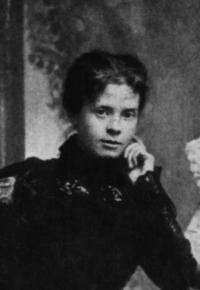
Alice Milligan in her youth.
One of the forgotten consequences of the partition of Ireland in 1920 is that a significant strand of nationalism was left isolated and ignored. In the South the official version of the national story underplayed the Northern Protestant involvement, and to be a Northern Protestant woman meant being ignored altogether. That is why this exhibition is so timely in reminding us that there were Irish patriots among that community and that women played a significant role in the cultural revival.
Born in Omagh in 1866, Alice Milligan was a cultural and political activist who was a friend and colleague of many leading figures in the Irish revival and advanced politics. The exhibition is incorporated into the National Library of Ireland’s ‘Discover Your National Library’, the ongoing programme to highlight different aspects of its collection. The emphasis is on telling Milligan’s story and her place in Ireland at the end of the nineteenth century and in the early twentieth century. As with the other exhibits in this room, there are touch-screens that enable the visitor to zoom in on the avatars of objects in the display cabinets, manipulate them and generally take a closer look than is possible with the actual objects themselves. I have praised the National Library’s use of this technology before and can only reiterate that it has revolutionised the visitor experience.
In the cabinets are a variety of books, manuscripts and publications associated with Milligan. She was a fervent propagandist who established and edited a number of journals over the years, such as The Northern Patriot and The Shan Van Vocht. These were not just political periodicals but also published poems, plays and stories, with the intent of promoting indigenous Irish culture. Milligan believed that political independence could only succeed alongside a strongly rooted cultural independence that was not dominated by the British media.
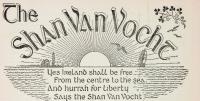
The Shan Van Vocht—one of a number of journals edited over the years by this fervent propagandist.
A flavour of the milieu in which she operated is provided by examples of other publications from this time, like the pamphlet The Gaelic League—what are its objects? published by unionists to attack that particular organisation. Other contemporary items include plays taken from the Irish, a certificate of the Wolfe Tone And Ninety-Eight Memorial Association, political cartoons and so on.
Wandering from cabinet to cabinet, it is easy to get lost in reflections about this phase of Irish history and what might have happened had the progressive, radical patriotism exemplified by Milligan and her ilk prevailed. What a different Ireland it would have been. There is a refreshing optimism obvious in almost everything with which she was involved, whether periodicals or poems, lectures or tableaux vivants. You can read what she wrote and appreciate the breadth of her interests as you move from one cabinet to the next examining books, magazines, photographs and sketches. Even in this small space I was struck by the wide variety of projects in which she was involved and the number of important people with whom she worked. Although based in Belfast for most of her life, she was acquainted with national figures like W.B. Yeats, James Connolly and Arthur Griffith.
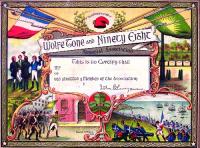
A certificate of the Wolfe Tone And Ninety-Eight Memorial Association, one of the many contemporary items on display.
Milligan was involved in many areas of culture. She was a feminist and patriot who also wrote poems and promoted the Irish language, as well as being a playwright and propagandist. The last two were combined in her staging of tableaux vivants in which actors recreated scenes from Irish history and mythology. In truth, the photographs depicting these can appear slightly ridiculous to the modern eye—like that of Queen Maeve and her daughter—but they were immensely popular in their day and introduced Irish culture to people who might otherwise have shied away from it. The large panels in the exhibition give descriptions of these tableaux, along with the other activities in which she was involved.
As the emphasis is on explaining Milligan’s life and legacy there is probably more
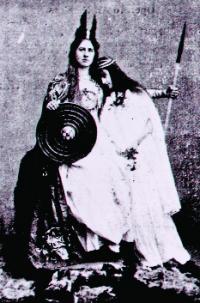
Queen Maeve and her daughter—one of the tableaux vivants staged by Alice Milligan recreating scenes from Irish history and mythology.
reading to be done than is usual, but it is a sign of how much this once towering figure on the Irish cultural scene has been forgotten that such a level of explanation is required. It is certainly worth reading the information on the panels as well as the excellent booklet written by Catherine Morris, the exhibition curator.
Milligan often employed magic-lantern slides when giving a lecture and the spirit of this is captured in the images projected on the back wall. As well as pictures of Alice herself, these vivid black-and-white photographs show places associated with her, people she knew and significant events like the funeral of Charles Stewart Parnell. This helps to add atmosphere to the gallery and, along with the various books, diaries and so on, enables a three-dimensional impression of the woman herself to emerge.
The National Library of Ireland has gone out of its way to promote this exhibition. The story of Alice Milligan has caught the imagination and articles about her have appeared in the national press. Every visitor can leave not just with memories of the woman in question but also with a copy of the booklet and even a lapel badge. It not only promotes another part of the library’s collection but also brings out into the open a significant part of recent Irish history. By focusing on Milligan, it reminds us that the movement for national independence was advanced on many fronts and that Northern Protestant patriots, poets and feminists all played their part. People like Milligan—and she was by no means alone—did not fit in with the sectarian consensus that prevailed in both parts of Ireland after partition and they slipped out of the narrative. This
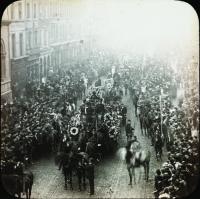
The funeral of Charles Stewart Parnell—one of many photographs that add atmosphere to the gallery.
exhibition is to be commended not just for being interesting in its own right but also for bringing people like Alice Milligan back into public view. HI
















